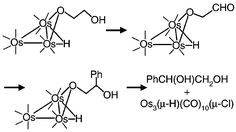Chemical transformations on diols anchored to a triosmium cluster
Abstract
Clusters of the general formula Os3(μ-H)(CO)10(μ-O–OH), 2, have been synthesised from the reaction of Os3(μ-H)(CO)10(μ-OH) with the appropriate ![[double bond, length as m-dash]](https://www.rsc.org/images/entities/char_e001.gif) CH2), 5, or react with PhMgBr to give Os3(μ-H)(CO)10(μ-OCH2CH(OH)Ph), 2e. Cluster 2a can also be functionalised at the cluster metal core with PPh3 as Os3(μ-H)(CO)9(μ-OCH2CH2OH)(PPh3), 6.
CH2), 5, or react with PhMgBr to give Os3(μ-H)(CO)10(μ-OCH2CH(OH)Ph), 2e. Cluster 2a can also be functionalised at the cluster metal core with PPh3 as Os3(μ-H)(CO)9(μ-OCH2CH2OH)(PPh3), 6.


 Please wait while we load your content...
Please wait while we load your content...